The Audio Chain: Reel to Reel Tape
An old idiom states, “a chain is only as strong as its weakest link”. As audiophiles, we are constantly striving to improve the fidelity of our playback systems by identifying the weakest links in our systems and looking at equipment upgrades, room treatments, and/or exotic tweaks such as cables and power conditioners to eliminate them. But no matter how hard we try to enhance the sound of our playback systems, we don’t have a lot choices when it comes to the native fidelity of the distribution formats available. We all have to acknowledge — AND accept — that there are very real limits associated with every music reproduction format. Setting aside personal preferences and individual taste, distribution formats have specifications that quantify— and limit — their potential fidelity.
Reel to Reel
Back in August, I discussed the audio chain associated with the venerable vinyl LP (click here to read that article). Today, I’d like to to talk about another popular music format: analog tape recording and playback — the reel to reel tape deck. If you’re lucky enough to have owned and operated a tape deck, you’re a member of a very small club. I’ve written numerous posts about my experiences with an early 3 1/4″ rim drive toy recorder to the 3M 56 16-track beast I purchased and used for years early in my career. I still own my Nagra IV-S and an Ampex 440-C. Tape recording has been a big part of my professional life and my time at the university.
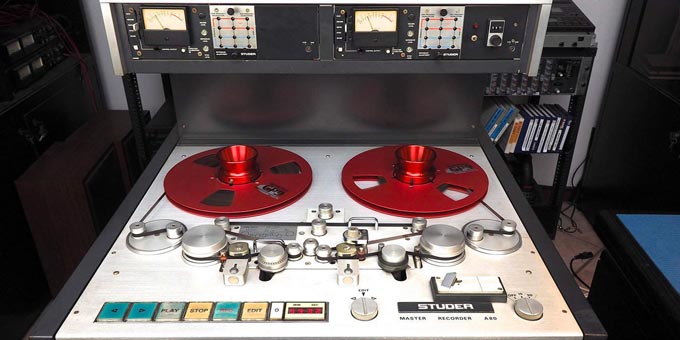
NOTE: These ancient machines are still used by mastering professionals for transfers. Fred Thal (see below) reports that they often have flutter that measures off the charts.
Understanding the basic theory of magnetic recording and the basic operations associated with recording and reproduction are still topics I teach in my basic audio recording class. Why? When virtually all recordings are produced and distributed digitally, what possible relevance does analog recording have? The reason is because most of the existing catalog of “classic” recordings we cherish were captured on professional analog tape machines designed and built by companies like Ampex, Otari, 3M, Studer, and Sony. The best of these machines were complex, highly refined, and expensive. And they’re still in use in studios that cater to artists looking for that classic sound.
However, optimizing analog tape recording and reproduction is a challenging undertaking. There are dozens of electrical adjustments (repro, bias, EQ, and record levels) that have to be precisely set and physical alignments such as azimuth, zenith, and wrap that only skilled technicians can accomplish. As an experienced audio engineer, I like to think that I know my way around analog tape recording. As a second engineer at Mama Jo’s studio in North Hollywood (thanks to a job recommendation by one of the gurus of analog recording AND the designer of my 3M 56 16-track deck Dale Manquen), I was responsible for setting up all of the tape decks for upcoming sessions. I know what an MRL (Magnetic Reference Labs) alignment tape is and how to use one. I know how to set up a machine at various tape levels and I have a better than basic understanding of bias, magnetic flux, and retentivity. I suspect I’m like most other aging audio engineers. We know enough to set up an analog tape machine and make good recordings but we may not actually have the expertise to guarantee a state-of-the-art transfer. Which is the weakest link in today’s listening.
The First Analog to Digital Transfer
Yep. The all important transfer of an irreplaceable and very fragile archive tape (maybe the master or maybe a safety copy) from analog to digital determines the fidelity that we ultimately hear from our systems. In the previously referenced article, we looked at the provenance of an analog tape master to a cutting lathe and finally to a vinyl LP. The production path to digital distribution of older analog recordings should demand a state-of-the-art analog to digital transfer using the very best equipment. And the sad reality is the mastering rooms and the people that operate them at the major records labels are ill equipped to handle this critical responsibility. Yes, the technical people — audio engineers like myself — think they know what they’re doing and they assure the upper management executives that they’re up to the task. But in reality, virtually every digital recording we hear on any medium would be of higher quality if true experts were involved. People like Fred Thal of ATAE.
ATAE
I’ve known Fred for many years. I’m in awe of his dedication to the world of analog tape. Fred is probably the only individual working in the area of analog tape machines with the experience, knowledge, capability, and integrity to offer a solution to the problem of the weakest link — the transfer of legacy analog tapes to high-resolution PCM digital. His ultra high quality playback decks are optimized to minimize high-band flutter and deliver every last bit of fidelity that exists on the thousands of analog tapes in the vaults of the majors. And unlike many other makes and models, his precision-guidance low-tension machines can virtually eliminate risk to irreplaceable original master tapes if used by a trained operator. The wrong transport can easily stretch, damage or destroy a rare tape.
For over thirty years, Fred has tried to make the major labels see the importance of using specialized machines for the playback of their valuable master tapes in order to get truly optimum transfers. But to save money, they’re still using forty and fifty year old Ampex ATRs and Studer A80s. Because they think we won’t hear any problems.
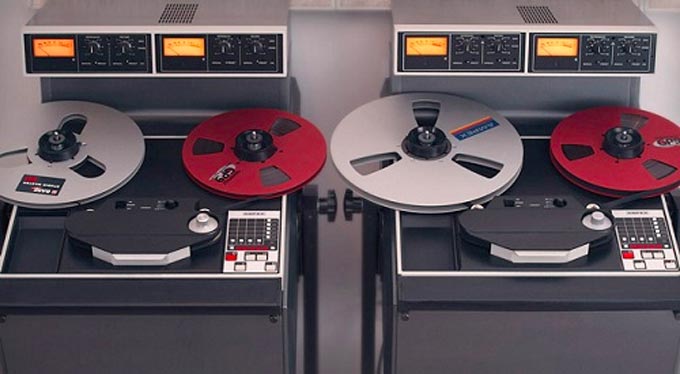
As much of an expert as Fred is in the world of analog tape machines, he’s been unable to convince the major labels — and their engineers — of the importance of doing a perfect analog to digital transfer. I’m hoping that there are individuals that read this and will want to know more about the new opportunities that exist for music lovers to hear cherished legacy recordings transferred on incredible state-of-the-art transfer decks that allow higher levels of fidelity to be captured than the compromised decks being used by the labels today. Nothing is more important than getting our analog past properly transferred to the digital future.
New opportunities exist for music lovers to hear cherished legacy recordings transferred on incredible state-of-the-art transfer decks that allow higher levels of fidelity to be captured than the compromised decks being used by the labels today.
So I’m making this appeal so we can help the labels understand the importance of doing tape to digital transfers optimally! Go to Fred’s website (click here) or write to me if you’d like more information and are interested in contributing to this important cause. Thanks.
Halloween Special Discount on the Book
If you have not yet picked up a copy of my “gold standard” book on high-end audio, please consider making your purchase this month. I’m offering a 50% discount off of the retail price of the paperback version until the end of November. Music and Audio: A User Guide to Better Sound makes a perfect holiday gift for your favorite audiophile or yourself!
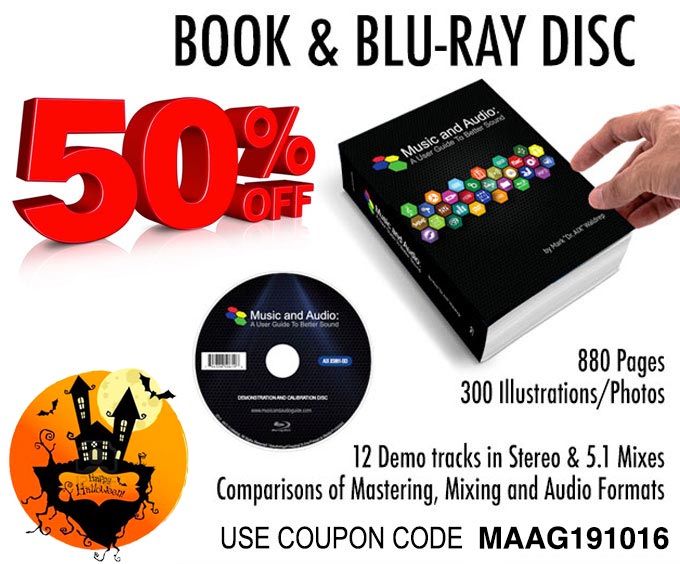
A New Book on High-Res Streaming
The more I begin to research the areas of high-resolution streaming, downloads, and personal audio, the more confused I get. The companies, reviewers, and websites pitching this stuff present a lot of conflicting and bad information in service to their bottom line. As much as I do not want to spend the next year of my life researching, writing, and illustrating another book, I’ve made the decision — a book on this topic is sorely needed. I will be raising the initial funds using Kickstarter once again. Stay tuned.
If you want to learn more about this new book or get on the mailing list, please visit: http://www.sdpaguide.com/. And if you have any specific areas that you would like me to address in the new book, please let me know. You can always write me at mwaldrep@aixmediagroup.com or enter your question in the online form on the website.
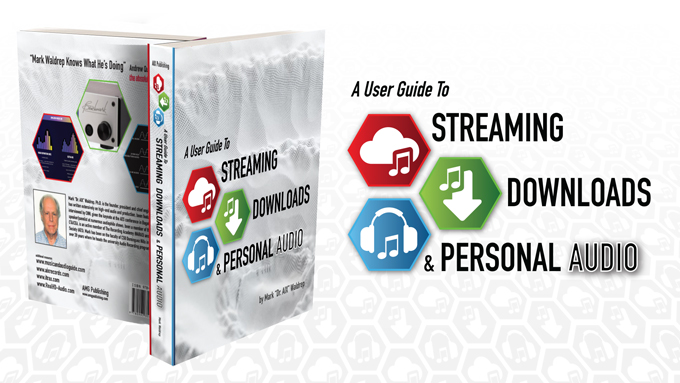
As always, thanks for your continued support. The world of high end audio deserves accurate information and I hope this blog remains a trusted source.

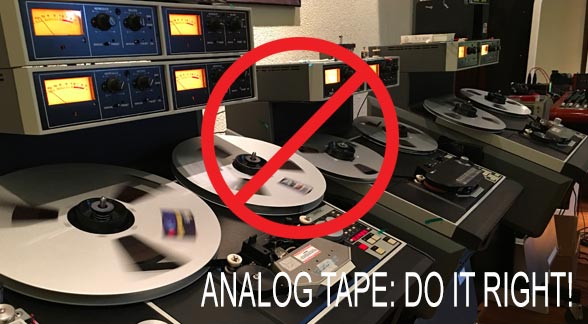
Hi Mark,
As someone whose favourite recordings of al time were recorded on analog tape I couldn’t agree more. I try to explain to people the starting point benefit of ‘hi-res’ is doing hi definition transfers from old analogue material that will potentially sound better than the records or cassette tapes we bought back in the day – but as you make clear it has to be done by skilled folk who understand the technology of the past and the present.
As far as the record companies’ getting behind doing the work of digitization on the best possible machines, don’t get your hopes up. MQA, DSD etc are about getting you to buy [insert name of ‘classic rock’ album here] another time, not about advancing the state of the art. As Frank Zappa said in his autobiography, “If [the album] sounds bad, it goes out anyway… it’s only ‘product’ to them.” Things have only gotten worse since then. Many ‘remasters’ actually sound worse than their predecessors; more ‘processed’. There are exceptions, like the Plangent-processed ‘Kind of Blue’. But mostly it’s just old wine in new bottles. The technology exists to do it right, but it costs more, so it won’t happen.
Thanks for your comment. I agree with the you. The executives at the labels AND the engineering staff don’t know how poorly they are doing the digitization. The goal of helping Fred is to actually finish his Model Two transfer machine AND demonstrate the superiority of his new machine over the existing decks being used.
I’m glad someone mentioned Plangent. I seem to remember reading an interview where Jamie described demoing Plangent on maybe some Dylan catalog stuff to a label exec(s) and although everyone agreed the improvement was clear, they were not interested. Nice to know it’s still bottom line > fidelity.
The Plangant process is very impressive. I’ve heard restorations that were done on a couple of Bruce Springsteen’s projects and would agree that every transfer should be done with the very best state-of-the-art analog tape deck (NOT the tired machines that have historically been used) and then run through the Plangent process. The question to remaster and restore can then be considered on a case by case basis but at least we’ve got the very best possible digital version. And forget about MQA. No one wants a lossy, DRM’d process that alters the original.